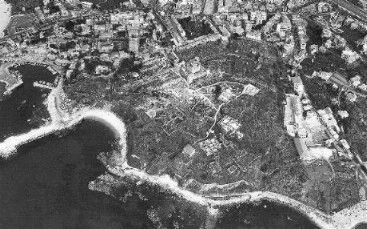Byblos
Jbeil / Byblos, formerly called Gebal or Goubal, is located about 37 kilometers north of Beirut, on a promontory at the edge of the sea. Archaeological excavations executed by Pierre Montet and especially by Maurice Dunand, have discovered traces of at least seventeen major phases or periods occupied from prehistoric times uptil the Arab conquest. Jbeil is one of the oldest inhabited cities in the world, continuously without interruption. It is listed, since 1984, as a World Heritage of Humanity by the UNESCO.
The Canaanites believed that the god El himself had founded Gebal (Byblos/Jbeil). More prosaic, archaeological excavations bring back its foundation to 7000 BC. The Neolithic man had constructed his first habitations in the shape of circular huts, surrounded by a "vegetable garden" in which all kinds of cereals were cultivated. These shelters evolved to become unicellular or rectangular houses, with walls constructed entirely of stone, supporting roofing of tree trunks and soil mixed with gravel (this method is still used today in the Lebanese mountains).
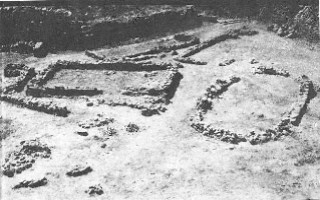
Funeral jars
These Canaanites or rather shall we say these Giblites (Gebal) have left many traces of their lives daggers, flint spear-points, bowls, basins and jars dried clay, etc. Ovoid jars were employed as grain silos, to store liquids such as olive oil or wine. These jars were also used for the burial of the dead, where the bodies were placed in a fetal form. These "funeral eggs" should thus allow a spiritual rebirth in the afterlife(1).
The Giblites have exploited the wealth of the region, including the vast forests of cedar, oak and pine trees that were covering the surrounding mountains. Egypt, at the Thinite period and the beginning of the Old Kingdom, provided a major market for their exported merchandise. The cedar wood was necessary to Egyptian shipbuilding as well as the construction of their temples, and the resin for their religious practices (mummification). The production of wheat and grapes (for wine) was abundant in Gebal, this trade was as important as the wood for Egyptians, so that these two products kept, in the hieroglyphic texts, their Canaanite names, qamhu (wheat) and karmu (vine). The ships returned to Gebal filled with gold objects, papyrus scrolls and Egyptian linen fabrics.

Cedar of Lebanon
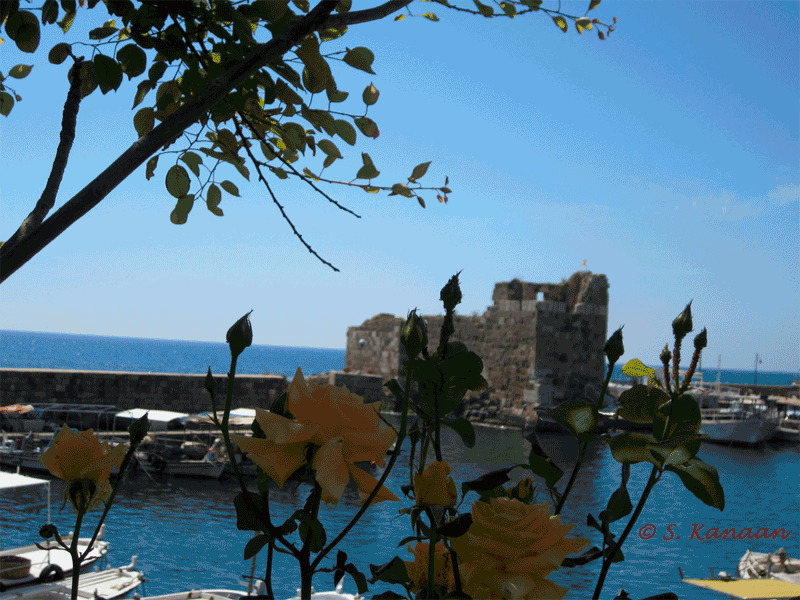
Port of Byblos
The antique city was constructed, as we have already reported for all other Phoenician cities, on a promontory overlooking a port that lies north, and which is still used today like a fishing port. The site is surrounded by several curtain walls, the oldest dating from the Third millennia (primitive rampart and rampart “saw-tooth”). The presence of several generations and civilizations was discovered on this place, archaeologists have uncovered a fishing village, prior to 4000 BC. Since then, the facilities have succeeded one another, and the transformation in city-state with its streets and infrastructure was initiated at the beginning of the third millennium. Its temples represented high places of worship and have a great reputation in antiquity. The preferred and permanently fixed relationship with Egyptians was beneficial to the development of the city for centuries.
With the forest exploitation of its hinterland, Gebal (Byblos) was the privileged partner of Egypt, as well as a center for economic, political and cultural exchanges. The city was mentioned extensively in various archives, found in Egypt and all over the Middle East. Among the most significant archives, we further note the 'Amarna Letters', which were discovered in 1887 in the site of ancient Akhetaten (Amarna today). These letters represent more than 380 documents (engraved on clay tablets), a large part from the Phoenician cities and especially Gebal and its king Rib-Haddi. To the East, the archives of Mari, who was a great Mesopotamian kingdom since the Third Millennium, mentioned on several occasions, the existence of trade and royal gifts from or arriving to the city of Gebal.
The center of the city was reserved for religious constructions, the oldest temple was dedicated to the goddess 'Baalat Gebal' (the Lady of Byblos). This temple was constructed in 2800 BC and destroyed by the Amorites, and then rebuilt by Yehawmlik king of the city (5th century BC). The greatest temple is known as the "L –Temple", for the shape of its main structure, its construction back to the second half of the third millennium (around 2300 BC), and no indication was found for its affiliation to a god. It was also destroyed by fire during the invasion of the Amorites. Another temple was erected there and it replaced the "L-Temple": The Temple of the Obelisks.
The temple of the male divinity, known as the "Temple of the Obelisks," was built around 1900-1600 BC, inside a sacred enclosure, which was reached by a vast courtyard. At the center was a big obelisk symbolic of the divinity, around which were disposed various cultic installations and many smaller obelisks established there to perpetuate the memory of devotees. The workshops of the temple produced votive elements, in which a series of bronze statues overlaid with gold leaf, parade hatchets decorated with gold filigree, terracotta objects... were found. This temple was deposited during archaeological excavations and displaced, and then reassembled in the same way to its current location. This reconstruction allowed discovering the ruins of the ancient temple the "L-Temple".
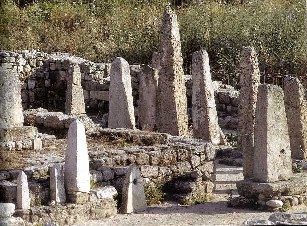
Temple Of Obelisks
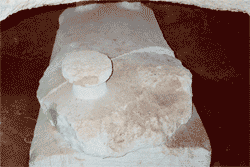
Royal necropolis
The royal necropolis was discovered by coincidence after a landslide caused by heavy torrent in February 1922 on the west side of the site. This flow brings up walls of an unknown structure at this date. The excavations undertaken by the archaeologist Pierre Montet and prosecuted by Henri Dunand, have revealed several tombs, the oldest was dug around year 2000 BC. Each monument is composed of a well in the rock (9-12 meters deep) leading to a funeral chamber. The most important of which was the tomb V excavated by P. V Montet in 1923, where the sarcophagus of King Ahiram with the first Phoenician alphabet were discovered.
Byblos has suffered, with the successive invasions of several civilizations, and had its ups and downs. Around 2300-2200 BC, The city, as many other cities within Phoenicia, was destroyed during the Amorites invasion. Most of the cities were not resuscitated, and have never been rebuilt (like Ugarit). However the most important port cities, including Byblos, were reconstructed and quickly regained their autonomy and their economic prosperity.
The relationship with Egypt is attested through frequent donations of the pharaohs. The tombs of the kings of Byblos contained rich pieces of Egyptian jewelry. During archaeological excavations, an obsidian gold box in the name of Amenemhat IV, as well as local jewelry shops imitating Egyptian motifs and techniques have been discovered in these graves. In the East, especially with the empire of Mari, Byblos has traded carpet and embroidered clothing, as notified by the archives of that city in the Euphrates valley during the reign of Zimri-Lim (1775-1761 BC).
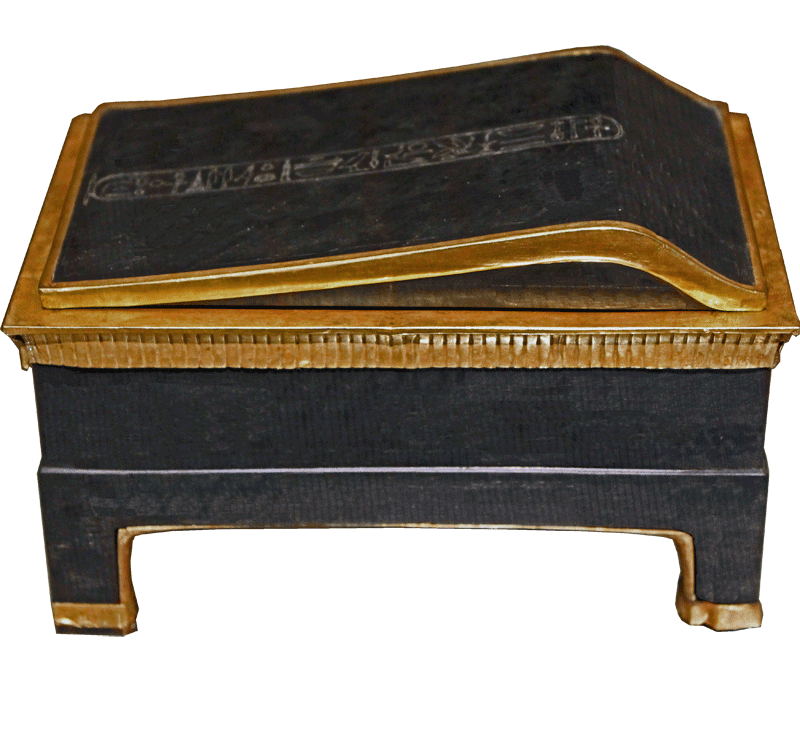
Gifts from Egypt
The history of the city at the time of Hyksos, invaders from the East, which dominated Egypt between 1650-1550 years BC, remains unclear. In another way and for the period after the expulsion of these Asian invaders, the subsoil of Byblos preserves many testimonials of the reign of Thutmose III, who, through several campaigns, founded an Egyptian empire in the East. During the reign of his son Amenhotep II, the city remained under the influence of Egypt. But when this Asian province collapsed under Akhenaten, who was only preoccupied with his religious reforms, the King of Byblos Rib-Haddi was exasperated, in vain, imploring Pharaoh for help to protect the city. Byblos briefly fell under the control of the Kingdom of Amurru - its northern neighbor - but regained its status as an autonomous city until the invasions of the Sea Peoples, around 1200 BC, ruined this new prosperity.
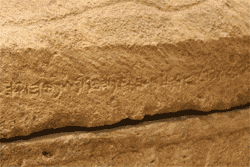
Sarcophagus of Ahiram
On the eve of the first millennium, Byblos re-emerged as a center of intellectual, commercial and artistic life. Wenamun, priest of the Theban court yard, was sent by the high priest to buy cedar wood necessary for the refurbishment of the boat of Amun around 1050 BC, annotated, in his writings, the autonomy of local princes. The intellectual life was marked by the invention of the Phoenician alphabet, identifiable with 19 of the 22 letters of the famous Ahiram sarcophagus King of Byblos around 1000 BC, discovered by a French archaeological team in 1923, during the period of French mandate, and now preserved in the National Museum of Beirut.
Since the end of the ninth century BC, inscriptions and monuments becoming scarce, Byblos was only mentioned in the Assyrians annals, enumerating the tributes it had to pay in order to maintain a relative political and economic autonomy. At the end of the seventh century, Phoenicia becomes a corridor for Egyptian troops, who reaffirmed their authority within the area, and on those of Babylonia opposing them by the power of arms. Byblos has no leverage to confront these conflicts. The name of the city was no more exposed, hence their mercenaries and woodworkers were hired by both opposing parties.
Under Persian rule and domination, Byblos enjoyed a period of economic renewal. Important military and religious architecture works were undertaken by its local kings (King Yehawmilk restored the sanctuary of the Baalat). The Giblites also contributed to the construction of Persian ships engaged in the Persian Wars. During this period, the ramparts of the city were strengthened and many defensive buildings were constructed, including the "Achaemenid fortifications" that remain, till this day, among the best preserved monuments of the archeological site.
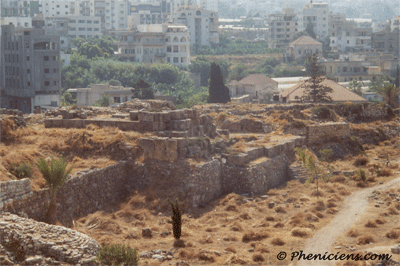
Achaemenid Podium
In the year 330 BC, following the defeat of the Persians at Issus against the Macedonians, the road to Phoenicia was wide open in front of Alexander the Great's army, the cities fell one after the other without resistance until arrival to the island of Tyre. Gebal, did not escape this fate and was occupied by the Greeks, it lost its autonomy and its Canaanite identity while adopting Hellenistic culture and traditions. At that time Gebal, the semetic name, was replaced by the Greek name Byblos, "Biblion" in Greek meaning "Mother City of writing" therefore "the book", and the city gave its name to the Bible.
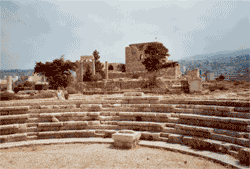
Roman Theatre
The Greek occupation ended in the year 64 BC with the arrival of the Romans, who enlarged the city by building new temples, baths, roads ... while adorning it with mosaics: the most important is that of the abduction of Europa, preserved in the National Museum of Beirut (MNB). They built roads bordered by columns, "East Via Appia" which begin in Byblos, and end in Damascus through the Bekaa Valley. During the excavations, Mr. Dunand was identifying the remains of a Roman theater where the majority of these stones were certainly used by subsequent constructions. Of the thirty rows of bench, there remained only five. The theater, being constructed over other archaeological layers, was dismantled and rebuilt, in front of the sea, few meters from its original location. It should be noted that the black pebbles in the middle of the theater, that indicate the location of a mosaic of Bacchus the wine god, also preserved in the MNB, without forgetting the small pediments with their Corinthian columns, the friezes, and the altar in front of the stands, and some holes in the stones of the first step which was used to fix columns so as to cover the scene with sails.
In 395, the Romans were replaced by the Byzantines. The reign of Constantinople ended in the year 637 with the Arab conquest. There are no traces of this period, archaeological excavations cold not so far reveal any monument of their presence in this city.
Jbeil remained under Arab occupation until the arrival of the Crusaders in the year 1104. They settled in the region for two centuries, and reinforced the fortifications of the ancient city and built a citadel using columns and stones recovered from the ancient ruins. The Crusaders were driven out by the Ayyubids who were replaced by the Mamluks. In 1516, after the Battle of Marj-Dabek, the Ottomans took possession of the city. Their reign lasted four centuries, ending with the First World War and the dismemberment of their empire. Lebanon was under French mandate from 1920 to 1943, the year of the country's independence. Jbeil becomes the capital of the Caza under the same name.
| (1) |
Hareth Boustany, "Byblos, du premier port à la cité phénicienne", Ulysse, n°68, Liban, Octobre 1999 |
Retour texte |
